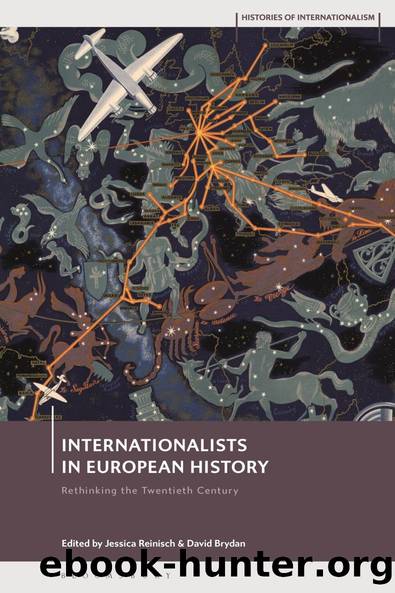Internationalists in European History by Jessica Reinisch David Brydan

Author:Jessica Reinisch, David Brydan [Jessica Reinisch, David Brydan]
Language: eng
Format: epub
ISBN: 9780198834595
Barnesnoble:
Publisher: Oxford University Press
Published: 2019-11-10T00:00:00+00:00
Part III
Internationalism as activism
9
Student activists and international cooperation in a changing world, 1919â60
Daniel Laqua
Mentions of student activism inevitably conjure up images of 1968 â a year in which protests on university campuses across the world were often framed in internationalist terms.1 This chapter, by contrast, draws attention to earlier varieties of student internationalism: it focuses on a period that predated both the growing appeal of New Left currents and a substantial expansion in access to higher education. Many student organizations that operated internationally before the 1960s engaged in knowledge exchange and cooperation with international institutions to further the interests of their constituency. Revolving around associational work and expert collaboration, their brand of internationalism resembled other varieties that are being explored in this volume.
Prior to the 1960s, university students were but a small subsection of their age cohort. Notwithstanding national variations, the participation rate in interwar Europe barely surpassed 2 per cent.2 By the late 1950s, this share had increased â but not in a way that drastically changed the overall picture.3 In Japan, student numbers were proportionally higher than in Europe: 4 per cent in 1940 and 7.5 per cent in 1952.4 The United States were an outlier, with around 8 per cent of young people attending college or university by 1940 as well as substantial expansion resulting from the G. I. Bill of 1944.5 In many other parts of the world, higher education remained even more of a minority experience than it was in Europe. The dynamics of empire were one major factor that shaped patterns of exclusion as well as scholarly mobility.6 Limited college or university provision in regions under colonial control subsequently informed debates about colonialism and international development.7
As a select band of people, university students were subject to major expectations regarding their potential contributions to society. In this respect, perceptions of students as future leaders intersected with broader ideas about youth. In his study of post-1945 France, Richard Ivan Jobs has noted that âyoung people as a group became the object of countless debates and innumerable government policies as they represented the hope of a future unburdened by the devastation of the recent pastâ.8 Visions of youth as a force for the ârejuvenationâ of society can also be applied to the specific constituency of university students and to the international activities that they engaged in. League of Nations officials during the 1920s, communist leaders during the 1930s as well as Cold Warriors from both power blocs during the 1940s and 1950s supported student organizations or sought to influence their work. Such forms of engagement anticipated that university youth might play an important role in the future.
University students were not a cohesive group. There were significant national differences with regard to their social profile, even though the low number of working-class students was a widely shared feature across different education systems.9 Womenâs participation in higher education tended to vary, too. Even within individual countries, the growth in the number of women students from the 1920s to the 1950s was by no means a linear process.
Download
This site does not store any files on its server. We only index and link to content provided by other sites. Please contact the content providers to delete copyright contents if any and email us, we'll remove relevant links or contents immediately.
Women and Jewish Marriage Negotiations in Early Modern Italy by Howard Tzvi Adelman(408)
Warrior King by Wilbur Smith(365)
18 real-life stories of serial killers and murderers with solved and unsolved killings from the USA, UK, Europe, and beyond. by Ben Oakley(287)
The Battle of Austerlitz by 50minutes(280)
Violence and Emotions in Early Modern Europe by Susan Broomhall;Sarah Finn;(274)
Who's Who in the Zulu War, 1879: The British by Adrian Greaves Ian Knight(272)
The American Crisis by Unknown(266)
Youth, Heroism and War Propaganda: Britain and the Young Maritime Hero, 1745â1820 by D. A. B. Ronald(239)
The Seeker by S. G. MacLean(229)
The Origins of French Absolutism, 1598-1661 by Alan James(220)
The Dutch East India Company and British East India Company: The History and Legacy of the Worldâs Most Famous Colonial Trade Companies by Charles River Editors(213)
The Traitor of Colditz by Robert Verkaik(200)
A Genius for Confusion by Richard M. Fried(199)
Invisible Worlds by Peter Marshall(199)
The Thirty Years War â Complete by Friedrich Schiller(199)
Fires of Faith by Catholic England under Mary Tudor(196)
Interest and Connection in the Eighteenth Century by Jacob Sider Jost(194)
The Opium Wars: Exploring the Addiction of Empires from Beginning to End by Ramos Adrian & Compacted History(193)
The Slave Trade in Africa by Simon Webb;(193)
